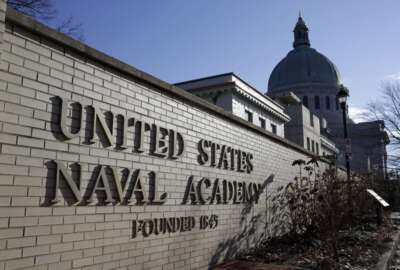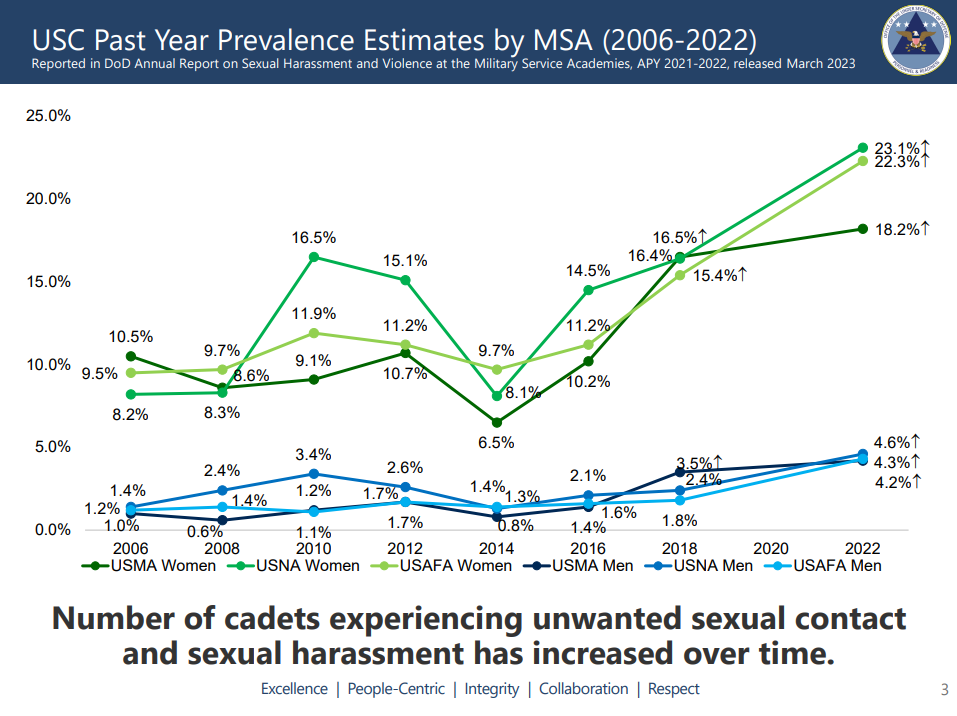

A report on sexual assault and harassment at the military academies recommends better access to mental health care and restructuring peer leadership.
Sexual harassment and assault at the service academies will continue to rise without significant changes to management and culture, according to a new study released by the office of the undersecretary of Defense for personnel and readiness (USD P&R) Thursday.
The number of cadets and midshipmen experiencing unwanted sexual contact and sexual harassment at the military service academies spiked since 2020 to an average of over 20% of women and 4% of men. Additionally, the report noted an increase in incoming midshipmen and cadets reporting incidents of sexual assault and harassment in the years before they entered an academy.

“This comprehensive look revealed that the training environment and overall climate at the academies are undermining their ability to prevent harmful behaviors,” said Beth Foster, executive director for force resiliency at the USD P&R at a media roundtable Thursday.
The Pentagon reported the dramatic uptick in reported harassment and assault in March. A memo from Secretary of Defense Lloyd Austin requested the new study as a result of those findings. In response to the new report, Austin ordered the head of each academy to have a plan of action in place to implement the study’s recommendations by Oct. 31.
The Coast Guard Academy also experienced a series of incidents of sexual assault and harassment. A report released in June concluded in some cases, those incidents were covered up by academy leadership.
The report recommendations included the need to change the way the academies structure leadership — specifically, stopping the practice of allowing upperclassmen to have authority over underclassmen without the supervision of seasoned military leaders. The report says this led to hazing and a lack of understanding of when to prioritize a student’s well-being over discipline.
“These pure leadership structures may have been effective in the past. Our findings suggest they may need some adjustment now. The culmination of this was a climate of cynicism, distrust and stigma. The cynicism and distrust really came from mixed messages — what was communicated and taught was a little bit different from what was modeled and reinforced,” said Andra Tharp, the senior prevention advisor for the office of force resiliency.
Tharp offered one example of a student at an academy who experienced a family tragedy. The student didn’t want to ask for mental health care at the academy because of the stigma associated with getting treatment. When the student asked to leave academy grounds for counseling, the officer in charge denied the request because the unit had a minor violation the week before, and no one in the unit could leave the grounds.
“The influence of that event wasn’t just about that cadet or midshipman not getting the help they needed at that moment. It sent the message to them and their peers that this is how you lead. This is how you care for people,” Tharp said.
While the study found common themes in the cultures at the three service academies, it also made distinctions between problems unique to each school.
The report said at the Air Force Academy, senior cadets had too much control over underclassmen and it led to mistreatment and hazing.
“These may be intended to create a bond within the class, but that’s certainly not everyone’s experience. Instead, they carry these negative experiences and unhealthy norms about how you treat others through their time at this service academy and into the force,” Tharp said.
At the Naval Academy, Tharp said peer leaders had no leadership training and didn’t know what to do.
“They said, ‘I didn’t know what to do when I became a real leader, so I just treated the midshipmen that I led the way I was treated.’ In some cases, that was probably a good thing, and in other cases that might not have been the most healthy way to treat people,” Tharp said.
Cadets at West Point reported that after being out in the field training with seasoned officers, they wanted that kind of leadership at school.
Among the recommendations the report made to the academies were improving access to mental health care, hiring more prevention personnel and improving the peer leadership structure. It also recommended the USD P&R establish a service academy climate transformation task force by Aug. 25 to provide feedback on the status of changes and new programs at the academies. Additionally, the academies should conduct regular surveys and prevention self-assessments to check their progress.
“These actions are essential to implement at the service academies not only because it’s essential for our cadets and midshipmen and their life at the academies, but because this is critical for their knowledge as future military leaders, this is critical to the readiness of the units that they will eventually lead,” Tharp said.
Copyright © 2025 Federal News Network. All rights reserved. This website is not intended for users located within the European Economic Area.
Alexandra Lohr, a former staff member, covered the Defense Department for Federal News Network until September 2023.

